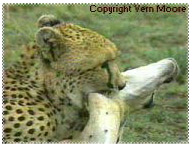




The cheetah (Acinonyx jubatus) is a large-sized feline (family Felidae) inhabiting most of Africa and parts of the Middle East. It is the only extant member of the genus Acinonyx. The cheetah achieves by far the fastest land speed of any living animal—between 112 and 120 km/h (70 and 75 mph)[3][4] in short bursts covering distances up to 500 m (1,600 ft), and has the ability to accelerate from 0 to over 100 km/h (62 mph) in three seconds.[5]
This cat is also notable for modifications in the species' paws. It is one of the only felids with semi-retractable claws, and with pads that, by their scope, disallow gripping.[6] Thus, cheetahs cannot climb upright trees, although they are generally capable of reaching easily accessible branches.
..\practice exam mariam murad
A cheetah is carnivorous and eats a variety of small animals. While most cats
are  nocturnal
predators, the cheetah is primarily diurnal, hunting in early morning and late
afternoon. Since it depends on sight rather than smell, it likes to scan the
countryside from a tree limb or the top of a termite mound. Other big cats chase
only a few hundred meters: the cheetah chases 3.4 miles (5500 meters) at an
average speed of 45 miles per hour (72 kilometers per hour). Stalking is as
important as the fast sprint: usually it will creep within 50 yards (46 meters)
of an intended victim before the final acceleration. Full sprints last about 20
seconds and almost never exceed 1 full minute. If it succeeds in catching an
animal the cheetah will suffocate it by clamping the animal's windpipe,
sometimes holding a clamp as long as 5 minutes. Very small animals like hares
are killed by a simple bite through the skull. But whatever the meal - large or
small - cheetah eats quickly for if challenged it will most often lose.
Cheetahs have unusually clean eating habits: they do not return to their kill
nor do they eat carrion; they leave the skin, bones and entrails of their prey.
At 6 weeks the young are strong enough to follow the hunt and when they are
about 6 months old the mother will capture live prey for them to practice
killing.
nocturnal
predators, the cheetah is primarily diurnal, hunting in early morning and late
afternoon. Since it depends on sight rather than smell, it likes to scan the
countryside from a tree limb or the top of a termite mound. Other big cats chase
only a few hundred meters: the cheetah chases 3.4 miles (5500 meters) at an
average speed of 45 miles per hour (72 kilometers per hour). Stalking is as
important as the fast sprint: usually it will creep within 50 yards (46 meters)
of an intended victim before the final acceleration. Full sprints last about 20
seconds and almost never exceed 1 full minute. If it succeeds in catching an
animal the cheetah will suffocate it by clamping the animal's windpipe,
sometimes holding a clamp as long as 5 minutes. Very small animals like hares
are killed by a simple bite through the skull. But whatever the meal - large or
small - cheetah eats quickly for if challenged it will most often lose.
Cheetahs have unusually clean eating habits: they do not return to their kill
nor do they eat carrion; they leave the skin, bones and entrails of their prey.
At 6 weeks the young are strong enough to follow the hunt and when they are
about 6 months old the mother will capture live prey for them to practice
killing.
Not so long ago cheetahs inhabited an area from North Africa to India, but they are now commonly found only in sub-Saharan Africa (south of the Sahara Desert). Their range includes sparse sub-desert, steppe (a treeless plain), medium and long-grass plains. They need an environment with bushes, tall grass and other large plants in order to hide from predators.
The cheetah originated about 4,000,000 years ago, long before the other big cats. The oldest fossils place it in North America in what is now Texas, Nevada and Wyoming. Cheetahs were common throughout Asia, Africa, Europe and North America until the end of the last Ice Age, about 10,000 years ago, when massive climatic changes caused large numbers of mammals to disappear. About that time all cheetah in North America and Europe and most of those in Asia and Africa vanished. Some experts think our present populations were derived from inbreeding by those very few surviving and closely related animals. This inbreeding "bottleneck", as theorized, led to the present state of cheetah genetics: all cheetah alive today appear to be as closely related as identical twins.